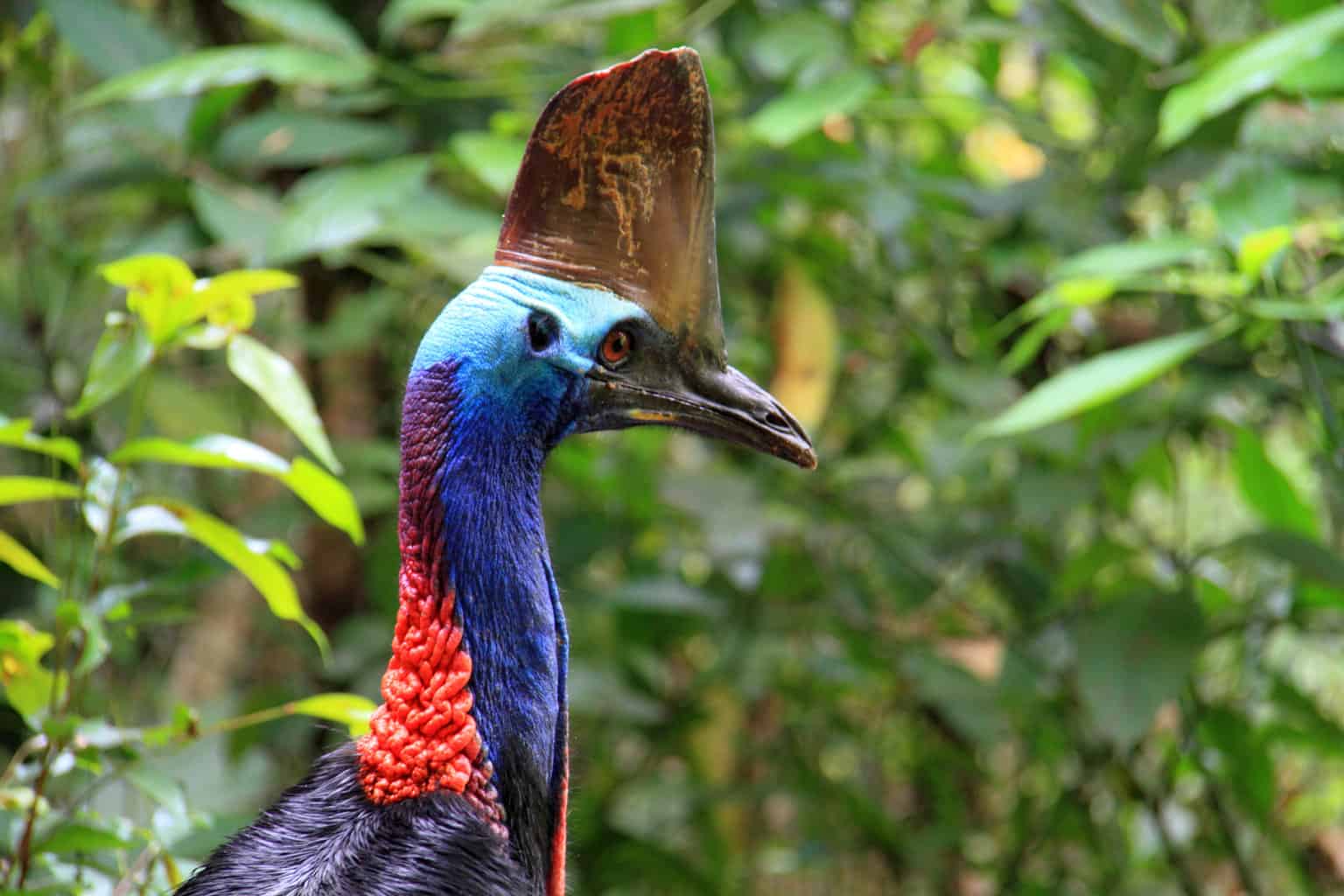The flightless Southern Cassowary has a great look–and a dangerous demeanor!
This big Australian bird is known for being a solitary, aggressive creature that has even caused a couple of human deaths in the past 100 or so years.
Let’s learn about this fascinating bird together…
What Does the Southern Cassowary Look Like?
The first thing you’ll probably notice on a Southern Cassowary is its big casque that sits on top of its head. This horn-like crown is brown and hard, measuring between 5.1 and 6.7 inches tall.
Additionally, the Southern Cassowary has a blue face, thick bristly black feathers, a long neck, 7-inch red wattles on the side of its face that hang down past the throat, and a red cape.
Its feet have three toes and one powerful, long claw on the inner of the three toes. This claw is up to 4.7 inches long and can cause a lot of damage! The legs and feet of a Southern Cassowary are already pretty intimidating, even without the claw. Add that claw, and you’re looking at a beast of a bird!
Males and females look similar to one another, but females are larger and have a taller casque.
How Big Is the Southern Cassowary?
As the largest member of the Cassowary family, the Southern Cassowary is one of the heaviest birds on earth. The only birds that are heavier are the common ostrich and the Somali ostrich. They weigh up to 187 pounds and have been documented at over 6 feet tall!
However, most of the time, females weigh around 129 pounds, and males weigh between 64-75 pounds. A typical height is between 4’ 11” and 5’ 11”.
The Southern Cassowary is the largest extant Asian bird and likely the largest Australian bird, although some individual emus may be taller.
Do Southern Cassowaries Attack People?

Unfortunately, the answer to this question is yes–cassowaries do, on occasion, attack humans. They are known for aggressive behavior and a powerful, damaging kick that is made even worse by the presence of those long, sharp claws.
Cassowary attacks usually occur when people have previously fed them. They tend to attack because they are trying to get food from people, but they will also defend their food sources, nests, and hatchlings.
There is some good news, of course. These attacks are rarely deadly. There have been two human deaths associated with Southern Cassowary attacks since records started being kept in 1900. There was a death in 1926 when two teenagers decided to kill a Cassowary they found on their property. The 16-year-old fell and was fatally kicked in the neck.
There have been 150 other documented attacks against humans. In 2019, another death occurred in Florida when a 75-year-old man fell and was killed by a cassowary he had raised.
The most important rule to remember is to avoid feeding cassowaries.
Where Does the Southern Cassowary Live?
In the wild, the Southern Cassowary lives in the tropical rainforests, mangrove forests, and melaleuca forests of northern Queensland in Australia. They are also found in Southern New Guinea and a number of Indonesian islands.
They are also relatively common in zoos around North America and the world.
Are There Many Southern Cassowaries Left in the World?
Southern Cassowaries are affected by habitat loss and overhunting, but they are still considered a species of Least Concern.
There are between 10,000 and 20,000 Southern Cassowaries around the world, with between 1,500-2,500 of those living in Australia.
Many zoos have successful breeding programs.
What Does the Southern Cassowary Eat?
Southern Cassowaries are foragers who eat fallen fruit, fungi, insects, and some small vertebrates.
They are helpful to humans and other animals because they can easily digest fruits that are otherwise toxic.
Breeding & Nesting Habits
Aside from the breeding season, the Southern Cassowary is a solitary creature who prefers to be alone.
They pair up for the breeding season, and the male builds the nest., which is like a thick mattress of plants and leaves.
Their breeding season call is loud and full of rumbling and hissing noises.
The eggs of a Southern Cassowary are bright green when they are laid, but they lose color over time. After the female lays these grainy-looking, colorful eggs, the male incubates them and does all the chick-raising on his own.
If you see an adult Southern Cassowary with its young, that’s almost certainly a male.
What Does the Southern Cassowary Sound Like?
Southern Cassowaries have a very low-frequency call that is almost non-vocal. You can hear the sound here:
As cool as the Southern Cassowary is, never forget that this large, wild bird is capable of inflicting some serious damage on humans!

